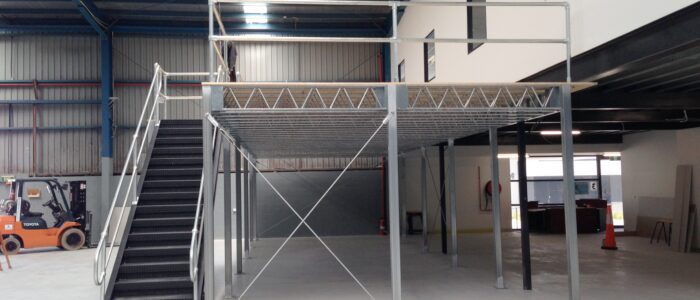What Is A Warehouse Mezzanine?
When it comes to expanding the floor space of a warehouse, a mezzanine or raised storage area is often a really good option. If you’re unfamiliar with what a mezzanine is and how it can fit into your existing warehouse, though, it may not have occurred to you as a good solution. After all, if you’re running out of warehouse space, there aren’t a lot of options beyond moving to a larger warehouse.
Let’s explore what a mezzanine is (and what it isn’t),and explain how it may be a good solution for your warehouse.
The Difference Between Adding A Mezzanine And Adding An Additional Story
Adding a mezzanine isn’t the same as adding another story to a building, especially in a warehouse situation. An additional story covers the entire floor below it while a mezzanine is open on at least one side. This is the biggest difference between a mezzanine and a new story on a building.
Going further, a new storey on a building is supported by the building itself, however, a mezzanine can be self-supported and independent of the building itself. Since a mezzanine is independent of the building it’s in, that also means that it’s relatively easy to dismantle and even move a mezzanine level.
As many commercial properties are rented, being able to remove a mezzanine level at the end of a lease is an important part of the make good process. So, because of this, a mezzanine actually becomes only a semi-permanent addition to a warehouse. One that can be removed and relocated at the end of a lease.
What Is A Mezzanine Floor Good For?
In an industrial setting, a mezzanine floor can be used for a variety of things. We’ve built mezzanines that are simply additional storage for a warehouse or factory. These raised storage areas may have things like forklifts stored or other equipment stored under them, so the mezzanine takes back that “lost” space for further storage. Other mezzanines we’ve built have warehouse shelving beneath them and on top of them. In this way the height of the shelving in the warehouse is effectively increased but with easy access throughout.
Another popular mezzanine design is to have the mezzanine supported by pallet racking, then use the mezzanine space for shelving, general storage, or anything else. There are a lot of possibilities.
All in all, a mezzanine can drastically increase the amount of floor space in an industrial space, whether that industrial space is a warehouse, factory, or something else.
Can Mezzanines Fit Into Small Or Oddly Shaped Spaces?
While most mezzanine floors that we build as a simple square or rectangle, they can be customised to fit almost any space. This means that if there’s only a small space in a warehouse that needs a mezzanine, we can design a smaller mezzanine to fit that space. If that space is a non-standard shape, we can also design the mezzanine for that.
Going further, there are also a lot of options for mezzanines in regards to height. Although safety always needs to be considered, a mezzanine can be designed to almost any height. It’s also possible (and relatively common) to create a double mezzanine with two stories to it.
Exactly how the mezzanine is designed and how it’s built depends entirely on the circumstances and the needs of the industrial space.
Is A Mezzanine Right For Your Business?
It very well may be, however, the only way to tell would be for an expert like us at Colby Dandenong to take a look. Sometimes the solution storage problems in a warehouse is to build a new mezzanine, sometimes the solution is to install a different type of pallet racking, and sometimes the layout needs to be reworked. Feel free to speak to us on how to improve your warehouse.


Comments are closed.